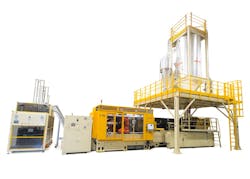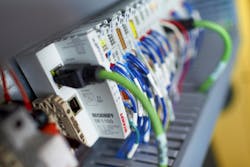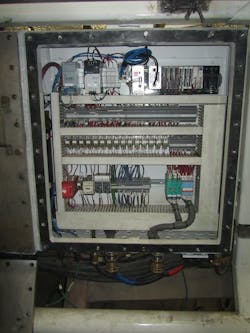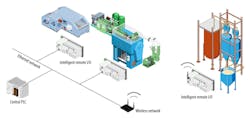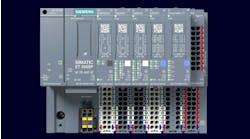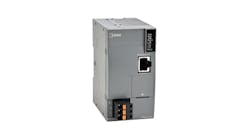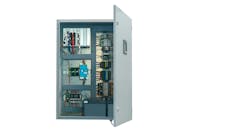Remote I/O becomes smaller, faster, customizable and intelligent
After working as a semiconductor process engineer, Hank Hogan hung up his cleanroom suit and now writes about process control and other technologies from Austin.Out of sight better not be out of mind, at least when it comes to machine I/O.
Whether they’re inbound sensor data or outbound actuator commands, real inputs and outputs are an important part of what makes an automation scheme work, even if what’s being controlled is a good distance away. In such cases or when otherwise beneficial, there’s remote I/O, the distributed digital and analog I/O modules gathering signals in remote locations and connecting them to a central controller.
Long used and familiar, remote I/O is undergoing changes and innovations. It’s getting smaller, faster, customizable and intelligent.
Remote space
One OEM taking advantage of advances in remote and local I/O technology is Husky Injection Molding Systems. The Bolton, Ontario-based company’s machines make many of the preforms that become PET plastic beverage bottles.
Figure 1: Husky Injection Molding uses I/O advances to add functionality so users can lower total production cost of plastic bottle preforms.
Source: Beckhoff Automation
Figure 2: Exploiting remote and networked I/O and other technologies, Husky improved system accuracy, machine responsiveness and repeatability.
Source: Beckhoff Automation
The company leverages networked I/O and many other technology innovations in its new designs (Figure 1). The result is that the latest Husky machines have cut materials costs by hundreds of thousands of dollars annually, in line with an industry-wide trend to reduce raw material use. These machines also have provided productivity and cycle time gains of up to 12%, according to Roman Pirog, director of development engineering at Husky.As part of these improvement efforts, the company is always adding functionality to its machines and so always requires more I/O and I/O modules (Figure 2). The challenge is that the machine footprint and the footprint inside cabinets are fixed. The solution is to deploy higher-density I/O technology, so it’s possible to fit many more I/O points in the same or smaller space, explains Endel Mell, electrical design team leader.
The use of distributed and networked EtherCAT I/O brings other benefits, he adds. The availability of diagnostic tools, for instance, makes it possible to pinpoint problems with both the equipment and the end product. Also, the technology allows signal oversampling because it supports rates of up to 100,000 samples per second. Such advances minimize control loop delays, increase control accuracy and maximize uptime, all of which are valuable to Husky and its customers.
For its machines, Husky uses products from Beckhoff Automation and has been doing so for over 15 years. For instance, one of the company’s latest machines, finalized at the end of 2013, includes a range of EtherCAT-based I/O terminal modules from Beckhoff.
Husky’s global array of facilities manufacture injection molding machines, hot runners, molds and integrated systems. It has thousands of machines in the field.
Remote build to suit
For medium- to large-sized machine builders, Beckhoff has introduced an I/O system that plugs into customer-specific circuit boards. “It’s a remote I/O concept that’s been customized to a fine level of detail,” says Kurt Wadowick, Beckhoff I/O and safety specialist.
Also read: 2015 State of Technology Report: I/O Systems
Thus, the modules will be tailored for a given set of relays, process transmitters and other specific I/O. It can include anything currently available in the company’s EL terminals. The resulting circuit board will consequently have everything needed for a given machine. The board can be designed by the customer or Beckhoff.
The benefits of this approach are simpler wiring, reduced assembly errors and easier and faster repeat assembly, says Wadowick, who assures there also will be lower overall system cost, although the components of the customized solution may be more expensive than the corresponding discrete components. An added plus is that the new customized I/O modules are smaller by about 40% when compared to Beckhoff’s EL equivalent.
Some non-recurring engineering expense is involved in the customized approach because the plug-in board has to be designed. For small runs, this extra expense will overwhelm the cost savings. The crossover point is roughly 100 systems a year, according to Wadowick. For volumes higher than that, the total costs come down significantly.
Remote decisions
Expansion of remote I/O brings benefits, but it’s not the right choice for all situations, says Kevin Wu, distributed I/O product manager at Siemens Industry. If the I/O count is low, then machine-mount solutions may make more sense. The dividing line varies, but generally remote I/O is most cost-effective when 50 channels or more I/O points are involved, he says.
[pullquote]The reason is because remote I/O goes into a cabinet. With a small number of added points, that cost can more than make up for the lesser expense of such I/O as compared to a machine-mount solution. Similarly, it may make more sense to put higher-density I/O in an existing cabinet as a way to expand. The cost of an additional cabinet may tip the balance in favor of a local, non-remote I/O solution.
In the right circumstances, though, remote I/O is the most cost-effective way to add capabilities. Some Siemens innovations should further improve on this advantage. For instance, the company offers bus adapters, a removable module that plugs into a remote I/O interface and allows swapping out Ethernet ports.
Many remote I/O interface modules have integrated Ethernet ports. These ports are the ones into which cables are plugged and unplugged. “Over time, when you do that, you could damage that port,” Wu says.
The result could mean that the entire interface module has to be replaced. That sounds simple, but it involves IP addresses and device configuration. Getting both right can be time-consuming. The Siemens solution avoids such issues because it allows a defective port to be exchanged for a working one. This fix is substantially less expensive than the cost of an entirely new module, Wu says. It also can save time and headaches.
On the horizon could be much higher bandwidths. In 2012, Siemens released a new I/O family with a backplane that it says is capable of 40-times-greater bandwidth than existing technology. The new I/O is designed so that its bandwidth can be updated in the future through a firmware change, thereby providing protection against demands for increased bandwidth that may arise over time.
Local control, remotely
At Fond-du-Lac, Wisconsin-based Helmer Electric, remote I/O has made its projects considerably easier. The electrical contractor designs and installs fully automated PLC systems (Figure 3), some of which are used to control construction, excavation and mining machines. These machines and the distances spanned are not small.
Figure 3: Remote I/O has extended the reach of solutions in the cabinets of construction equipment.
Source: Helmer Electric
“We have one instance where we had our main processor about a mile away,” says Adam Nisler, Helmer lead technician. “It depended on where they were in their construction project, but it was about a mile away.”Getting data for monitoring and control back and forth over such distances in the past meant running long and large specialized cables, which made the solution expensive. What’s more, determining when and where such cables failed could be difficult, which made troubleshooting a challenge. Indeed, getting a machine up and running might require a technician to make a trip on-site, which could be costly and time-consuming.
Implementing the right technology changed the situation. “With the remote I/O, we did it through TCP/IP. You’re able to run an Ethernet cable wherever you needed to go, and we had a fiber backbone for it, as well, so we didn’t have any issues with distances,” Nisler says.
"In designing remote I/O solutions, a balance has to be struck," he adds. For instance, sensor data needs to be distributed in time and space so that it paints a complete picture, but too much I/O can create information overload, burden PLCs and cause other problems. Also, Helmer’s customers do not want work to stop because a cable is damaged.
Communication between an Opto 22 programmable automation controller (PAC) and the remote I/O processor runs over a standard Ethernet-based network. Data is exchanged using a memory-mapped protocol based on the IEEE 1394 standard. Communication using SNMP, EtherNet/IP and other protocols are also supported.
Opto 22 touts the advantages of intelligent remote I/O (Figure 4). Because the remote I/O is brainy, such a distributed approach lessens the burden on a central controller, makes solutions easier to scale and minimizes single points of failure. Loss of a connection, for instance, does not necessarily lead to such situations as tanks overfilling due to pumps not being shut off.
“If your I/O at a remote location has the intelligence to run PID loops, then even if all communication to that remote site is lost, your critical processes will continue to run,” says Mary St. John, Opto 22’s director of training.
Figure 4: Intelligent remote I/O enables functionality to continue even if communications are cut.
Source: Opto 22
With the advent of wireless communication and Internet-enabled technologies, it’s possible to do global remote I/O, as in gathering sensor data from points on the other side of the world. However, since communications can sometimes be unreliable, St. John advises it’s best to also log data locally. In this way, even if links go down, critical data is not lost.
This local data logging is similar to having intelligent remote I/O enabling local control functions at distributed locations. This intelligent remote I/O allows the process or machine to remain functional if communication is lost.
A remote future
"Remote I/O advances could cut the cost of the entire solution," says Eugene Spiropoulos, senior technical solutions consultant and DCS solutions manager at Yokogawa of America, which offers smart configurable I/O technology. “The purpose is to provide remote I/O modules out in the field that can be software configurable for any of the four basic I/O types. You can terminate different types of I/O on one termination strip, one I/O module, and then pretty much tell those channels what they’re supposed to be.”
Programmatically changing between digital input, digital output, analog input and analog output with a few keystrokes and wiring modifications simplifies the hardware.
The effect is to separate control development from that of the hardware. For example, a program running on a tablet can stand in for the control application and can be used to validate I/O signals. This can happen while development of the control application is underway. If there are changes to the control application that translate into hardware changes, the configuration of the I/O can be adjusted through software alone.
The impetus for this new technology came from customers, Spiropoulos says. “The industry required a change in the way they were executing automation projects.”
This approach means automation projects can be developed in modules. What’s more, those modules are not in the critical path for larger projects, an approach that customers value, according to Spiropoulos, who says this technology can reduce cabinets, wiring and other costs, thereby reducing total install costs. This can be important in remote or offshore locations, where installation can be quite expensive.
While there may be significant cost savings, the real benefit lies elsewhere, Spiropoulos says. “The key thing is project flexibility. You do save a lot on the schedule, but more importantly you save a lot on the risk.”

Leaders relevant to this article:


